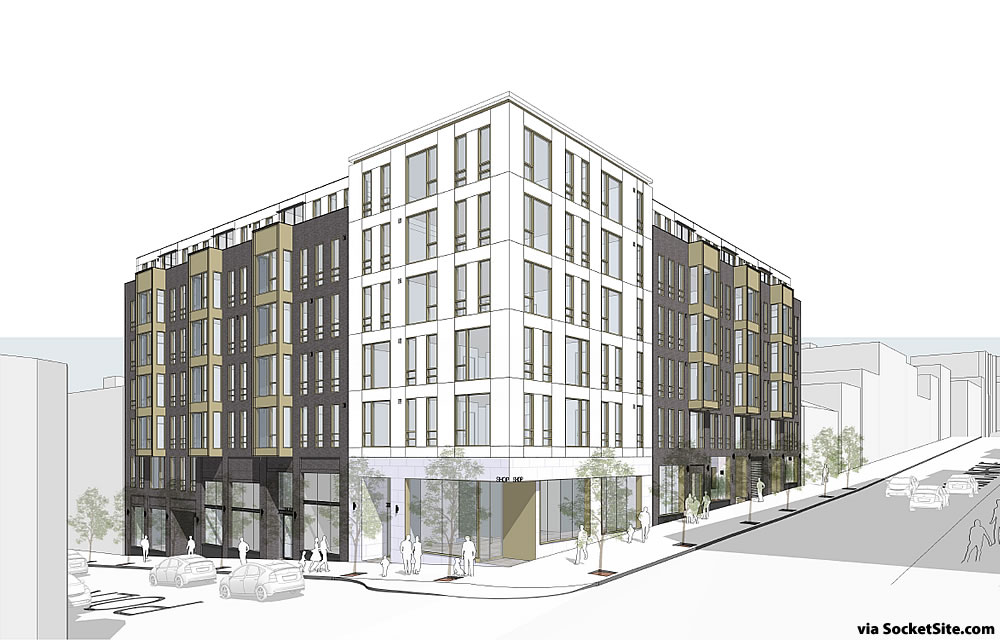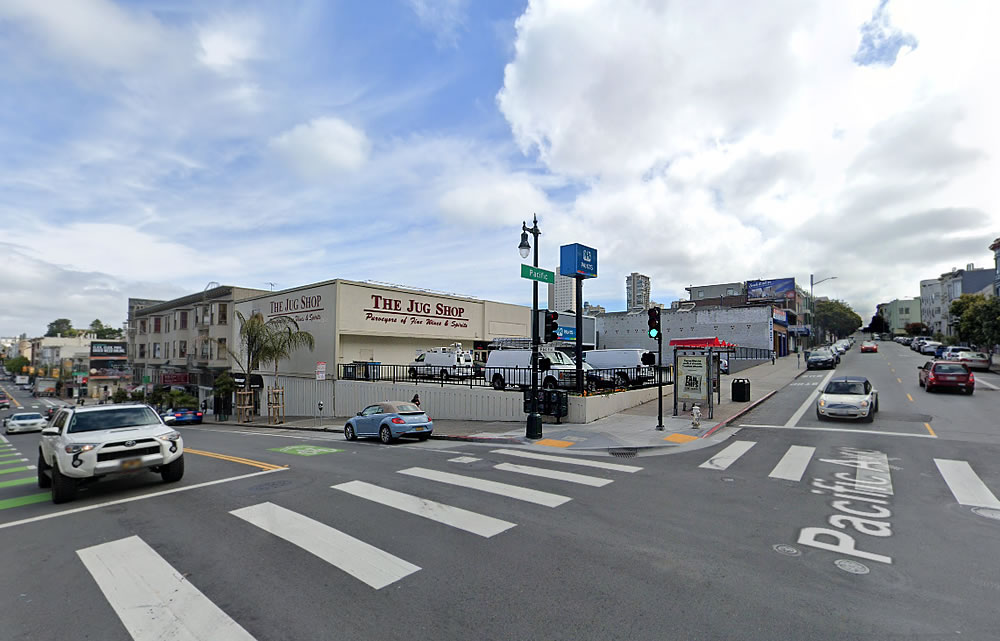With the refined plans for a denser, 53-unit building to rise up to 65 feet in height upon the current Jug Shop complex site, on the northeast corner of Polk and Pacific, having been approved and permit requests for the project having been filed, the project team is positioning to break ground this summer.
With that in mind, the Jug Shop is planning to move down the street to the landmark building at 1648 Pacific Avenue. But once the new “1580 Pacific Avenue” building is built, the Jug Shop intendeds occupy a portion of the brand new retail space which will front both Polk and Pacific.


A Fantastic use for a very underutilized piece of real estate – old school parking lots from 1950’s era thinking have passed their prime and should be the first to be developed in land and housing starved SF
Glad the Jug Shop found a new landlord. They’re friendly people.
Even happier, of course, that we’ll be seeing much-needed new development in a vibrant stretch of Polk Street.
Very happy the Jug Shop lives to serve another jug.
How much more of this mediocre cookie-cutter “architecture” can this city hold?! When is enough.. too much?
I like it. I hope we keep building more. It is a substantial improvement over the building that is currently there.
Massive and mediocre — the new San Francisco style
Once again, literally nobody who will choose to live there cares. Not everything has to be an architecturally unique snowflake, nor does it have to be in a “traditional” (i.e. historical) style. These kind of entirely subjective complaints are just not substantive in any way.
100% agree
100% disagree (with you Bobby and anonymous). There is no reason mediocre building design has to be the outcome, even if we don’t necessarily need “unique snowflake” or “traditional” buildings — these aren’t the only architectural alternatives, and the issue is NOT “entirely subjective”. Each city has a range of good, to mediocre, to bad architecture – and SF has far too much of the [latter] two, while other cities in other locales are filled with great contemporary architectural design (residential, commercial, retail and civic) throughout their urban fabrics…
Nobody is asking for unique artistic snowflakes or Victorian clones, but people who care about the qualities that make SF special aren’t receptive to clumsy, generic, bro-boxes that are basically a developer’s raised middle finger to communities that will have to live with the product for generations. Like the camel’s nose under the tent (although nowhere as aesthetically pleasing as a dromedary’s proboscis), once it’s in, it sets a bad precedent encouraging further lazy and witless cookie-cutter revit grid structures that would be more at home in downtown Duluth (no shade meant for the apossitely-alliterative Duluth) than a few blocks from some of the world’s most renown points of scenic and cultural interest.
Just curious if you’ve ever been to the Sunset. Miles of ugly cookie cutter boxes that people have convinced themselves are acceptable because they’re old. This is at least as attractive and a way better use of space.
Yes, the sunset monotheme isn’t the most aesthetically pleasing.
But this standard issue box isn’t either.
Just curious why you’re comparing small one- or two-unit houses with backyards to a 63-unit complex?
This building is as attractive as a herpes sore, and “way better use of space” is a normative statement that makes sense when considered from the banker/builder/landlord/used house salesman’s rentier perspective, but is highly questionable when considering what makes a neighborhood appealing (and for whom).
But you’re making my point. Once the clunkering condo horse has left the barn, it’s difficult for a neighborhood to claw back a human sense of scale and design. Instead of the appealing, neighborhood-friendly design and mixed-use variation one gets with organic development over many years (of which Valencia was a great example), building booms force future generations to live with the block-killing, cookie-cutter products borne of large-scale profit-maximization.
The curses future generations will direct towards the condo and office developers of the last twenty-five years will rival those now directed at Justin Herman, although to be fair, the banker/builder crime syndicate couldn’t care less what the future will think of them.
Yeah, why can’t San Francisco look like Carmel By The Sea?
PS if you have something that looks like this growing on your body, it’s probably not a herpes sore.
“[…]Carmel By The Sea”
Thank you for getting the reductio ad absurdum out of the way. Now, about this putrid design inflicting pain on the neighborhood for generations to come…
I completely agree. For all the process this city goes through to approve new projects, we end up with a depressing amount of mediocrity.
Well. Clearly some people who come here care what it looks like. Don’t their opinions matter? Pretty callous to dismiss them like that just because you value chasing a dollar over beauty and SF civic pride.
It’s a good project – replacing parking with housing – and it should get built ASAP.
But if San Francisco ends up looking indestinguishable to Hacendia Business park then what’s the reason to live here instead of there? Not everything needs to be a architectural snowflake, but not everything needs to be a beige stucco box either. There is a middle ground and its perfectly reasonable that reasonable people will seek it.
Why are our billionaires not building some trophy buildings to show off?
Because building anything in San Francisco is expensive, time-consuming, and subject to the political whims of a public who want property crime unchecked but property design under their thumb. It’s easier to make ones and zeroes do what you want.
Also, limited labor pool, super-expensive building materials and a city with a secular population decrease? I don’t think they will be breaking ground any time soon.
Gross. Dont need any more trophies to show off the rampant wealth inequality here.
If we’re doomed to block uniformity now, can we at least get some sweet classic concrete Brutalist?
I am sure this comment is sarcasm, because Stanley Saitowitz and his collection of concrete enthusiasts at Natoma Architects are still around and throwing up their monstrosities unabated by the state of the local economy or anything else.
This is truly awful. There are many architects in SF who could design a building with the same number of units but with some considerable modern or contemporary panache. Why is it that we see so many of these “value engineered” monstrosities that could not be built today in NY or Boston?